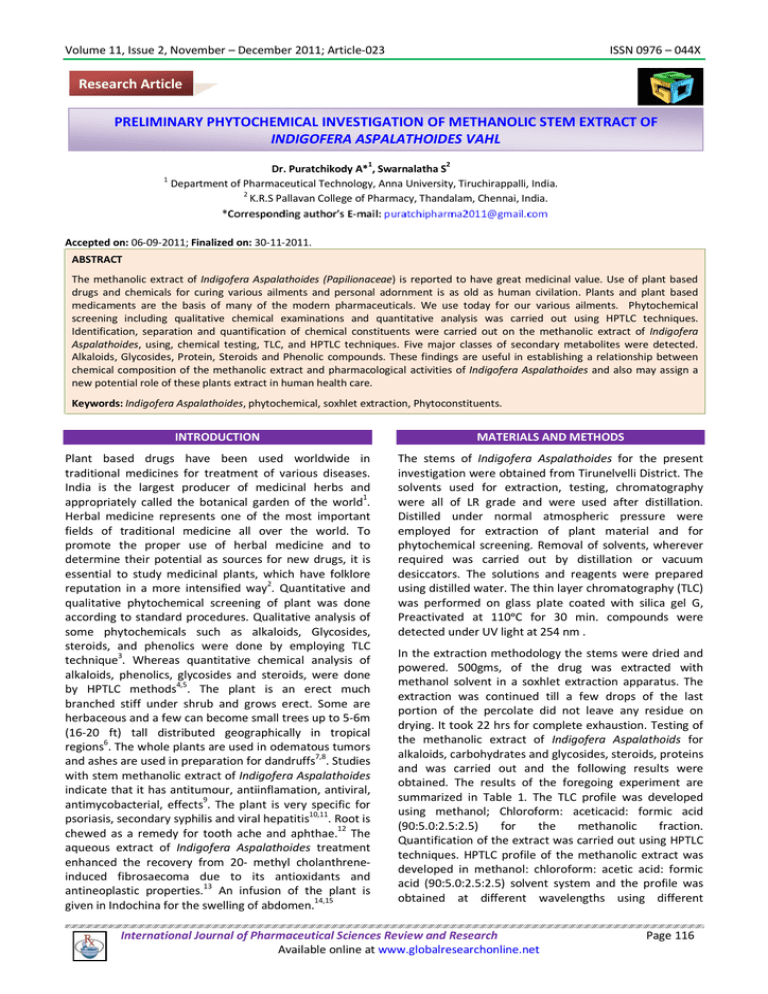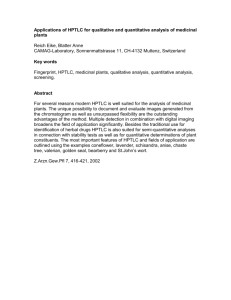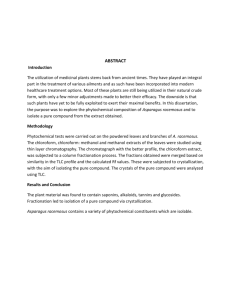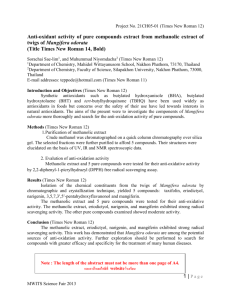Document 13308211
advertisement

Volume 11, Issue 2, November – December 2011; Article-023 ISSN 0976 – 044X Research Article PRELIMINARY PHYTOCHEMICAL INVESTIGATION OF METHANOLIC STEM EXTRACT OF INDIGOFERA ASPALATHOIDES VAHL 1 1 2 Dr. Puratchikody A* , Swarnalatha S Department of Pharmaceutical Technology, Anna University, Tiruchirappalli, India. 2 K.R.S Pallavan College of Pharmacy, Thandalam, Chennai, India. Accepted on: 06-09-2011; Finalized on: 30-11-2011. ABSTRACT The methanolic extract of Indigofera Aspalathoides (Papilionaceae) is reported to have great medicinal value. Use of plant based drugs and chemicals for curing various ailments and personal adornment is as old as human civilation. Plants and plant based medicaments are the basis of many of the modern pharmaceuticals. We use today for our various ailments. Phytochemical screening including qualitative chemical examinations and quantitative analysis was carried out using HPTLC techniques. Identification, separation and quantification of chemical constituents were carried out on the methanolic extract of Indigofera Aspalathoides, using, chemical testing, TLC, and HPTLC techniques. Five major classes of secondary metabolites were detected. Alkaloids, Glycosides, Protein, Steroids and Phenolic compounds. These findings are useful in establishing a relationship between chemical composition of the methanolic extract and pharmacological activities of Indigofera Aspalathoides and also may assign a new potential role of these plants extract in human health care. Keywords: Indigofera Aspalathoides, phytochemical, soxhlet extraction, Phytoconstituents. INTRODUCTION MATERIALS AND METHODS Plant based drugs have been used worldwide in traditional medicines for treatment of various diseases. India is the largest producer of medicinal herbs and appropriately called the botanical garden of the world1. Herbal medicine represents one of the most important fields of traditional medicine all over the world. To promote the proper use of herbal medicine and to determine their potential as sources for new drugs, it is essential to study medicinal plants, which have folklore reputation in a more intensified way2. Quantitative and qualitative phytochemical screening of plant was done according to standard procedures. Qualitative analysis of some phytochemicals such as alkaloids, Glycosides, steroids, and phenolics were done by employing TLC 3 technique . Whereas quantitative chemical analysis of alkaloids, phenolics, glycosides and steroids, were done 4,5 by HPTLC methods . The plant is an erect much branched stiff under shrub and grows erect. Some are herbaceous and a few can become small trees up to 5-6m (16-20 ft) tall distributed geographically in tropical regions6. The whole plants are used in odematous tumors and ashes are used in preparation for dandruffs7,8. Studies with stem methanolic extract of Indigofera Aspalathoides indicate that it has antitumour, antiinflamation, antiviral, antimycobacterial, effects9. The plant is very specific for psoriasis, secondary syphilis and viral hepatitis10,11. Root is chewed as a remedy for tooth ache and aphthae.12 The aqueous extract of Indigofera Aspalathoides treatment enhanced the recovery from 20- methyl cholanthreneinduced fibrosaecoma due to its antioxidants and antineoplastic properties.13 An infusion of the plant is given in Indochina for the swelling of abdomen.14,15 The stems of Indigofera Aspalathoides for the present investigation were obtained from Tirunelvelli District. The solvents used for extraction, testing, chromatography were all of LR grade and were used after distillation. Distilled under normal atmospheric pressure were employed for extraction of plant material and for phytochemical screening. Removal of solvents, wherever required was carried out by distillation or vacuum desiccators. The solutions and reagents were prepared using distilled water. The thin layer chromatography (TLC) was performed on glass plate coated with silica gel G, Preactivated at 110ᵒC for 30 min. compounds were detected under UV light at 254 nm . In the extraction methodology the stems were dried and powered. 500gms, of the drug was extracted with methanol solvent in a soxhlet extraction apparatus. The extraction was continued till a few drops of the last portion of the percolate did not leave any residue on drying. It took 22 hrs for complete exhaustion. Testing of the methanolic extract of Indigofera Aspalathoids for alkaloids, carbohydrates and glycosides, steroids, proteins and was carried out and the following results were obtained. The results of the foregoing experiment are summarized in Table 1. The TLC profile was developed using methanol; Chloroform: aceticacid: formic acid (90:5.0:2.5:2.5) for the methanolic fraction. Quantification of the extract was carried out using HPTLC techniques. HPTLC profile of the methanolic extract was developed in methanol: chloroform: acetic acid: formic acid (90:5.0:2.5:2.5) solvent system and the profile was obtained at different wavelengths using different International Journal of Pharmaceutical Sciences Review and Research Available online at www.globalresearchonline.net Page 116 Volume 11, Issue 2, November – December 2011; Article-023 concentrations. The TLC pattern of the following extract is given in Fig .1-3. HPTLS Profiles ISSN 0976 – 044X CONCLUSION In conclusion it may stated that the approach given for standardization of any new herbal or medicinal plant includes chemical evaluation and comparison should be developed systematically for completion of database of newer plants. This shall help to obtain monograph of the future medicinally active plant. For developing analytical method pure active chemical constituent should be isolated in further study and identification on basis of reference standard shall be made. This also helps in setting in house standards of the medicinal plants used extensively by herbal manufacturers. Acknowledgements: The authors thank to Bogar Herbal Analytical Research Centre for providing all the facilities to carry out this work. Figure 1: at 254 nm Figure 2: at 366 nm Figure 3 REFERENCES 1. Arvind J, Mungole, Ravi Awati, Alka Chaturvedi, Prakash Zanwar. Preliminary Phytochemical screening of Ipomoea Obscurs (L) – A Hepatoprotective Medicinal Plant, International Journal Of Pharm Tech Research, 2(4): 2010.2307-2312. 2. Kumaraswamy MV, Kavitha HU, Satish S. Antibacterial Evaluation and Phytochemical Analysis of Betula Utilis D.Don Against Some Human Pathogenic Bacteria, World Journal Of Agricultural Sciences, 4(5): 2008. 661-664. 3. Harborne JB. A Guide to Modern Techniques of Plants Analysis, phytochemical methods. 1998. 4. Edeoga HO, Okwu DE, Mbaebie BO. Phytochemial Constiuents Of Some Nigerian Medicinal plants, Afri. J. Biotechnol. 4 (7): 2005.685-8. 5. Waterhouse AL. Determination of total phenolics, Current Protocols In Food Analytical Chemistry Wrolstad, RE, Wiley, 2001.11.1.1-11.1.8. 6. Puratchikody A, Swarnalatha S. Pharmacognostical Pharmacological, Investigation On Indigofera Aspalathoides Vahl, Journal Of Pharmaceutical and Biomedical Sciences, 5(23): 2011.1-4 7. Shailendra gurav, Vijay Gulkari, Nankishore Duragkar and Arun Patil. Pharmacognosy, phytochemistry, pharmacology and clinical applications of Gymnema Sylvestre R BR, Department of pharmaceutical sciences, 1(2): 2007. 414-443. 8. Malaya Gupta,Upal K, Pallab K. Anticancer activity of Indigofera Aspalathoides and Wedelia Calendulaceae in swiss albino mice, Indian Journal of Pharmaceutical Research 6(2): 2007. 141-145. 9. Rajkapoor B, Murugesh N, KavimaniS, Krishna DR, Ravichandran V. Antimycobacterial, Antiviral and Cytotoxic Studies of Indigofera Aspalathoides Vahl, Pharmacognosy Magazine, 3(11): 2007. 163-166. RESULTS AND DISCUSSION Preliminary phytochemical testing of methanol extract shows the presence of various phytoconstituents such as, Glycosides, Alkaloids, carbohydrates, steroids, glycosides, proteins, and phenolic compound. TLC profile of the methanolic extracted developed using methanol: chloroform : acetic acid : formic acid (90:5.0:2.5:2.5) at different concentration 5UI, under UV 254nm and 10 UI under UV 366 nm and After derivation with VSR and 5 min heating and after derivation with VSR and 10min heating also shows the presence of three silent spots. The HPTLC chromatogram (Fig. 4-7) developed using methanol: chloroform: acetic acid : formic acid solvent system shows the presence of three peaks with maximum area under the curve indicating the possible quality of these three phytoconstituents in the methanolic stem extract. 10. Indian Medicinal Plants, A Compendium of 500 Species, Orient Long Man, 1997,5(2):404-406. 11. Selvakumar S, Karrunkaran CM, Rao MRK, Balasubramanian MP. Inhibitory Effect of Indigofera Aspalathoides on 20-methylcholanthrene–induced International Journal of Pharmaceutical Sciences Review and Research Available online at www.globalresearchonline.net Page 117 Volume 11, Issue 2, November – December 2011; Article-023 ISSN 0976 – 044X chemical carcinogenesis,Journal of carcinogenesis, 10(1): 2011.1-7. chemical carcinogenesis, Journal of carcinogenesis, 10(1): 2011. 1-7. 12. Philips Abraham, Arul V, Sachu Philip, Padmakeerthiga B, Nirmal Madhavan, Sethupathy S. Effect of Indigofera Aspalathoides Leaf Extract on hepatic Xenobiotic Enzymes Activity In Hamster with DMBA Induced Oral Cancer, International Journal of Drug Development and Research, 2(3): 2010.476-481. 14. Rajkapoor B, Murugesh N, Kavimani S, Krishna DR, Ravichandran V. Antimycobacterial, Antiviral and Cytotoxic Studies of Indigofera Aspalathoides Vahl, Pharmacognosy Magazine, 3(11): 2007.163-166. 15. Kirtikar KR and Basu BD. Indian Medicinal Plants, Oriental Enterprises, Dehra Dun, 3(2): 2001.997-999. 13. Selvakumar S,Karrunkaran CM, Rao MRK, Balasubramanian MP. Inhibitory Effect of Indigofera Aspalathoides on 20-methylcholanthrene–induced ********************* International Journal of Pharmaceutical Sciences Review and Research Available online at www.globalresearchonline.net Page 118




